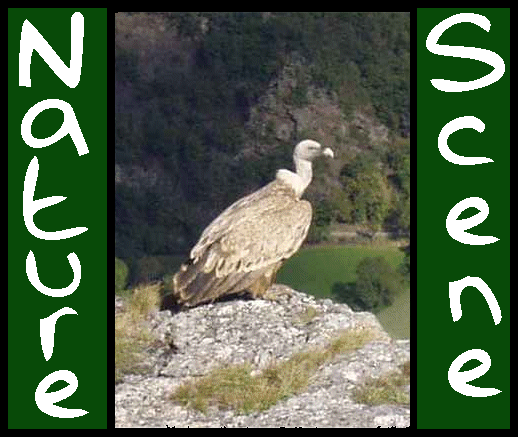
Welcome to NATURESCENE'S
BOTANY ARTICLES of the CÉVENNES
A selection of articles in French and English by David Dickenson of Naturescene, written for the official ALEPE site

|
We proposed a botanic outing to take a look at some relics of the Ice-Age. We were a brave foursome in the snow,
with a 100% glacial wind. This was 'botanic reality'. It was the last day of Spring, 2010, but the weather was winter.
One more contradiction, we were actually in the Aubrac, not the Cévennes.
Here, the soil is volcanic, not seen in the Cévennes for several hundred of millions of years. The flowers promised to bring us a lot of surprises. |
|
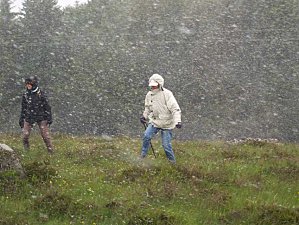
Photo 1 |
We parked at the Col de Bonnecombe, to whet our botanic appetites. Here, around a lake carved out during the Ice Age, almost all the orchids to be seen were the Heath Spotted Orchid (Dactylorhiza maculata), with little risk of contradiction. They were, however, a little difficult to verify, because of a horizontal snowstorm (photo 1). |
|
A wind of just 3 °C, with gusts of 100km/hr, this last day of Spring was to be our 'bontanic reality'.
If we had spotted a mammoth, we would not have been surprised.
We admired our first carnivorous plant, the Round-leaved Sundew (Drosera rotundifolia) (photo 2), and looked forward to seeing our second carnivorous species. At the extremity of this lake, we had been told, were a group of butterworts. However, we searched and searched without sucess, and were very happy to return to the car. |

Photo 2 |
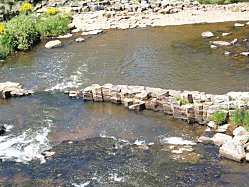
Photo 3 |
Imagine our surprise when we stopped at the Negro Bridge, several kilometres further on, to take a
look at the 'organ pipes' (photo 3) , these octagonal-shaped basalt rocks bearing the stigmata of the Ice Age,
forming the bed of the river.
There was an abundance of Large-flowered Butterwort (Pinguicula grandiflora) (photo 4) draping the rocks. These differ from the Butterworts of the Causses, mentioned in my blog of the Roc des Hourtous, by their large deep blue flowers. |
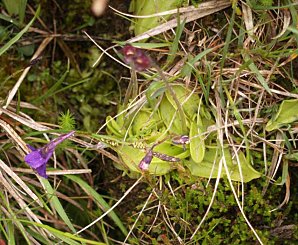
Photo 4 |
|
Just to the side, we noticed the red heads of the Marsh Cinqfoil (Potentilla palustris) (photo 5),
a frequent companion in marshland. Here, if in doubt, one simply precedes a plant name with 'Marsh'
(Marsh Forget-me-not, Marsh Thistle, Marsh Buttercup, Marsh Orchid (for all the unknown Dactylorhizas)
.....
I you want to be a snob, you can use the Latin 'palustris' instead of 'Marsh'. Its not difficult, and it works, for example Potentilla palustris, Botaniste palustris …... The only thing to complicate matters is the modern fashion to call a marsh or bog by its European approved name 'mire'. |
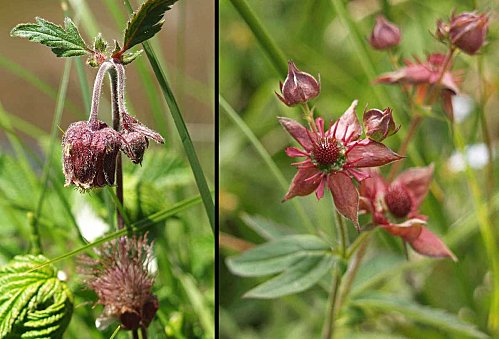
Photo 5 |
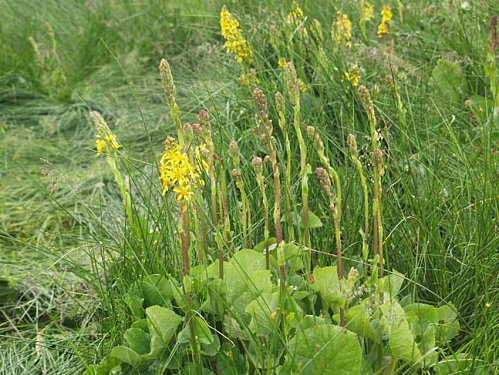
Photo 6 |
We are on the slopes of the Lac de Souveyrol, the remains of an Ice Age lake and marsh.
This left-over from the Ice Age is special.
It plays host to one of the rare colonies of Ligulairia (Ligularia siberica) (photo 6) in Lozère. We were too early to see the imposing tall flower spikes of this plant, resembling a giant ragwort, so I have included a photo taken a previous year. |
| Scattered on the slope are pockets of marsh, rich in both numbers of plants and species of Dactylorhiza, and above all, the yellow heads of two large members of the Buttercup family found in marshland, namely the Kingcup or Marsh Marigold (Caltha palustris) (photo 7) and the Globe Flower (Trollius europaeus) (photo 8) | |
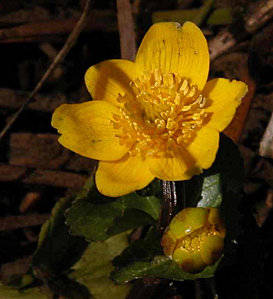
Photo 7 |
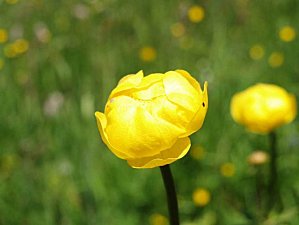
Photo 8 |
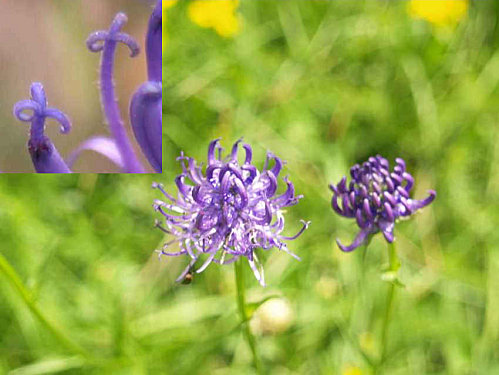
Photo 9 |
In the surrounding dryish pastureland, we found ourselves examining two different species of rampion. A mixture of the normal Spiked Rampion, common in Lozère, and the Round-headed Rampion (Phyteuma orbiculare) (photo 9). With its rounded head, and pistil with three lobes, we could easily see the difference. |
|
Two stalks of Dactylorhiza orchids attracted me. With their lax stems, and sparse flowers,
they appeared rather different, and I snapped their photos (photo 10). Later, looking through the books,
I became quite excited, thinking I had found Dactylorhyza traunsteineri, a species that had been reported only twice before in Lozère. But my hopes were dashed by Alain Jacquet, who has distinct reservations from my photos. A botanist's life is not a happy one. |
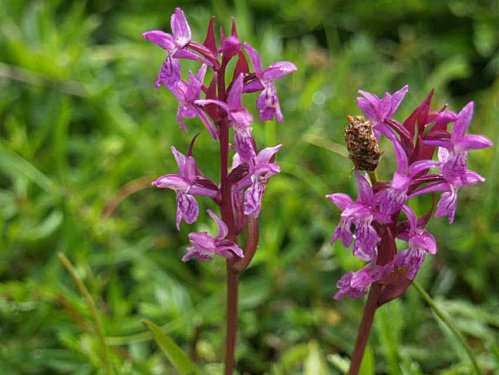
Photo 10 |
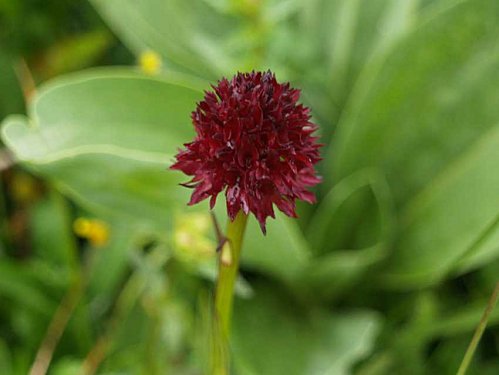
Photo 11 |
At last! We spotted our aim for the day. 90 minutes driving, icy showers, wet and muddy footwear,
and there we were! Two little red lollipops.
This is the only spot in all Lozère where the Austrian Nigratella orchid (Nigretella austriaca) (photo 11) can be found, and it is always like looking for a needle in a haystack. But, we got there. It was enough to take two photos and turn our back on the wind. |
|
But not before paying a visit to the Botanical Garden at Aubrac, to see a collection of all the flowers
to be found in the region that we had not seen to date.
We stopped briefly to milk the cow (photo 11), then, without wasting time, we made a bee-line for the Aubrac café, and packed down some enormous cakes, essential eating for the pilgrims doing the St. Jaques route, often soaked and exhausted like us. Photo 11 |
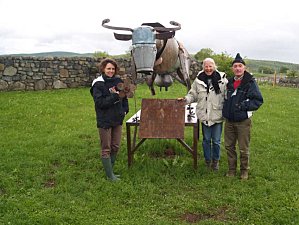
Photo 12 |
|
And during this punishing day, where was our dog?
She had remained curled up beside the fireplace at home. Having some beautiful dreams. What a lucky dog! |